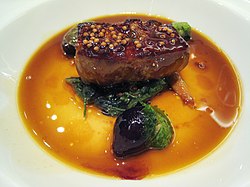KarlGrenze:
Any tumor big enough to be detected by eye is most likely getting that organ condemned (and maybe other organs too).
Big tumors have necrotic (dead), putrefying centers. Or they may have chunky, calcified areas (that were once dead putrefying centers). I don’t see the appeal in that.
However, because it is not naturally obtained, what about Pâté de foie gras?
Foie gras (lit. 'fat liver'; .mw-parser-output .IPA-label-small{font-size:85%}.mw-parser-output .references .IPA-label-small,.mw-parser-output .infobox .IPA-label-small,.mw-parser-output .navbox .IPA-label-small{font-size:100%}French: [fwa ɡʁɑ] ⓘ, English: /ˌfwɑːˈɡrɑː/ ⓘ) is a specialty food product made of the liver of a duck or goose. According to French law, foie gras is defined as the liver of a duck or goose fattened by gavage (force feeding).
Foie gras is a delicacy in French cuisine. I...
The result is tasty, but clearly big enough to be detected and not natural due to the force feeding procedure.
You have something I need.
I’ve heard of tumors having teeth and hair and even eyes sometimes – is that true? (If so, that would DEFINITELY render them inedible!)
GIGObuster:
KarlGrenze:
Any tumor big enough to be detected by eye is most likely getting that organ condemned (and maybe other organs too).
Big tumors have necrotic (dead), putrefying centers. Or they may have chunky, calcified areas (that were once dead putrefying centers). I don’t see the appeal in that.
However, because it is not naturally obtained, what about Pâté de foie gras?
Foie gras - Wikipedia
The result is tasty, but clearly big enough to be detected and not natural due to the force feeding procedure.
But that is not a tumor. Liver degeneration due to fat accumulation is not the same as if that liver had developed hepatocellular carcinoma.
And Guin, yes… Teratomas are tumors arising from germ cells that have not even differentiated and can easily transform to different tissues… or at least attempt to replicate those tissues.
